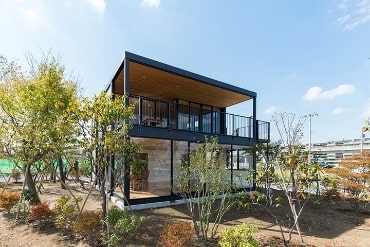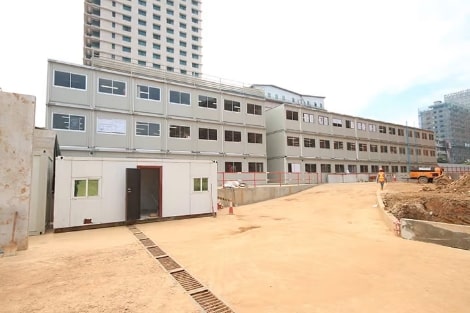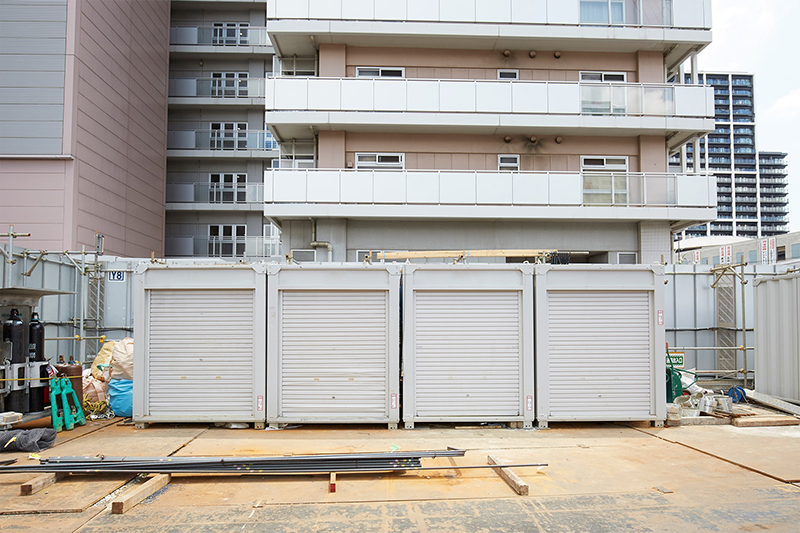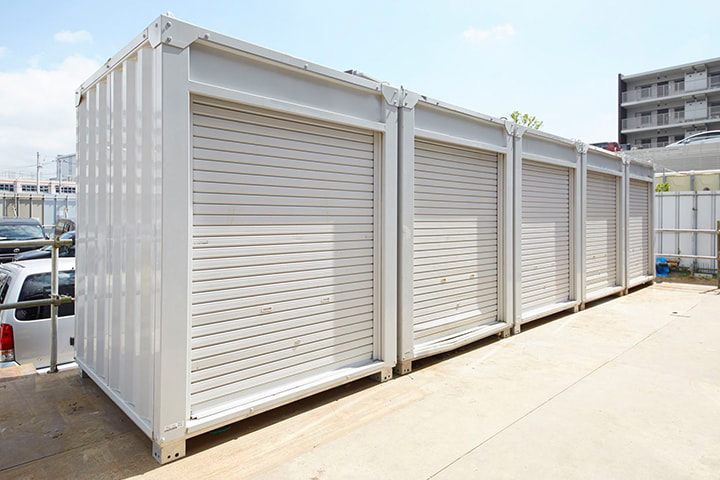Gorilla
The Gorilla is a portable storage unit to keep valuable cargo such as furniture, machines, or other essential goods protected from inclement weather.
Case Studies
Our case studies feature modular space solutions for various industries, such as retail, education, events and construction.
Explore how others have created their own modular spaces with Mobile Space by Sankyo Frontier.
Construction Firm
Construction Firm
Product Specifications
Gorilla | |||
|---|---|---|---|
Product Highlights |
| ||
Dimensions | (L x W x H) Exterior: 1894 × 1894 × 2423 Effective Interior: 1804 × 1739 × 2146 Effective Opening: 1500 × H1830 (Lightweight Steel Shutter) | ||
Total Floor Area | 3.14 m2 | ||
Ceiling Height | 2146 | ||
Structure | Lightweight Steel Frame | ||
Roof | Galvanized Steel Sheet (Thickness = 0.5) | ||
Ceiling | Plywood (Thickness = 6) | ||
Wall | Interior: (Thickness = 1.5) Folded Steel Plate with Powder Coating | ||
Floor | Base & Floor Frame: Hot-dip Galvanizing Floorboard: Checkered Steel Plate (Thickness = 2.3) with Hot-dip Galvanizing | ||
Floor Surface Load Capacity | 295kg/m2 * Please consult us beforehand if you wish to use or install heavy objects. | ||
Gross Weight | Approx. 500kg | ||
* These specifications are based on rental units in Japan. ** Dimensions are in millimeters. | |||
Gorilla | CT-J | MS1 | |
|---|---|---|---|
Product Highlights |
|
|
|
Dimensions | (L x W x H) Exterior: 1894 × 1894 × 2423 Effective Interior: 1804 × 1739 × 2146 Effective Opening: 1500 × H1830 (Lightweight Steel Shutter) | (L x W x H) CT-54J: 5890 x 2350 x 2675 CT-72J: 7390 x 2350 x 2675 CT-90J: 9444 x 2350 x 2820 | (L x W x H) 57MS1: 5821 x 2322 x 2800 75MS1: 7639 x 2322 x 2800 |
Total Floor Area | 3.14 m2 | CT-54J: 12.57 m2 (3.80 tsubo) CT-72J: 15.94 m2 (4.82 tsubo) CT-90J: 20.37 m2 (6.16 tsubo) | 57MS1: 12.60 m2 (3.81 tsubo) 75MS1: 16.64 m2 (5.04 tsubo) |
Ceiling Height | 2146 | 2343 | 2361 |
Structure | Lightweight Steel Frame | Light Steel Frame | Light Steel Frame |
Roof | Galvanized Steel Sheet (Thickness = 0.5) | Galvanized Steel Sheet (Thickness = 0.5) | Galvanized Steel Sheet (Thickness = 0.5) |
Ceiling | Plywood (Thickness = 6) | Finishing: Coated Plywood Board (Thickness = 4) Insulation Material: Styrene Foam (Thickness = 25) Moisture-proofing sheet | Finishing: Volcanic Vitreous Multilayer Board (Thickness = 6) Insulation Material: Phenolic Foam (Thickness = 20) Moisture-proofing sheet |
Wall | Interior: (Thickness = 1.5) Folded Steel Plate with Powder Coating | Composite Panel (Outer Wall & Inner Wall: Coloured Steel Plate, Insulation: Styrene Foam Thickness = 25) | Composite Panel (Outer Wall & Inner Wall: Coloured Steel Plate, Insulation: Phenolic Foam Thickness = 40) |
Floor | Base & Floor Frame: Hot-dip Galvanizing Floorboard: Checkered Steel Plate (Thickness = 2.3) with Hot-dip Galvanizing | Structural Plywood (Thickness = 12) Floor Paint Finish | Hardened Wood Chip Cement Board (Thickness = 18) Floor Paint Finish |
Lighting Equipment | – | 32W (Inverter Type) LED Light CT-54J: 3 units CT-72J: 4 units CT-90J: 5 units | (Inverter Type) LED Light 57MS1: 3 units 75MS1: 4 units |
Electrical Equipment | – | Ventilator Fan (20cm) Single Phase 3 Wire, Earth-leakage Circuit Breaker (30A) Branch Circuit Breaker (20A x2) | Ventilator Fan (10cm, 20cm) Single Phase 3 Wire, Earth-leakage Circuit Breaker (30A) Branch Circuit Breaker (20A x2) |
Floor Surface Load Capacity | 295kg/m2 * Please consult us beforehand if you wish to use or install heavy objects. | 295kg/m2 * Please consult us beforehand if you wish to use or install heavy objects. | 295kg/m2 * Please consult us beforehand if you wish to use or install heavy objects. |
Allowable Snowfall Amount | – | Standard: 50cm | 57MS1: 100cm 75MS1: 70cm |
Gross Weight | Approx. 500kg | CT-54J: Approx. 1530kg CT-72J: Approx. 1950kg CT-90J: Approx. 2500kg | 57MS1: Approx. 1690kg 75MS1: Approx. 2240kg |
* These specifications are based on rental units in Japan. ** Dimensions are in millimeters. | |||
You Might Also Be Interested In

MS1
The MS1 is the premium selection of modular units that is strong, energy-saving and highly versatile. It is also made 25% more rigid and 16% stronger than comparable products in the market.
Learn more
CT-J
The CT-J is a basic series of modular units with a unique folding structure that is strong yet economical. It can be used for portable offices, temporary site offices, temporary shops.
Learn moreFrequently Asked Questions
How much does a modular building cost?
The cost depends on your requirements for your unique modular space. We have different modular solutions available for purchase and rent, and the prices vary depending on your need. Fill in the enquiry form here, and our team will be in touch to conduct an in-depth personal consultation.
Are modular solutions expensive?
They don’t have to be. Depending on your needs, selecting the right modular products for rental or purchase is a low-risk, high-value investment.
For modular solutions on rental, the initial investment is lower than buying. However, it only becomes non-cost effective if the duration of usage is undecided and gets stretched on a month-to-month basis. When renting a modular space, it’s essential to have a clear idea of the exact usage purpose and duration to compare the cost and affordability of purchasing the modular space.
For modular solutions that are purchased, it becomes more cost-effective for long-term usage. Because of its durability, strength and higher customisability , it can serve as a long-term solution for brands that foresee the usage duration to be anywhere from 2 to 20 years.
Sankyo Frontier’s wide range of modular products allows you to find the best solutions to your needs. From the CT-J basic series to the Gorilla series, our modular spaces give you great flexibility and choice for industrial, residential or commercial purposes.
Fill in the enquiry form here, and a member of our team will be in touch to conduct an in-depth consultation with you.
What is the difference between renting and buying a modular building?
Requirements | Rental | Purchase |
|---|---|---|
Length of Usage | Ideal for temporary buildings for industrial or commercial purposes (between 1 day to 2 years) rental or purchase.
Rental modular products are suitable for use for up to 2 years. | Ideal for long-term establishments like schools, hospitals or other institutions |
Cost |
* Please note that costs may vary depending on the project’s requirements. |
|
How long do modular buildings last?
We have segmented our modular products to fit two modes of use — rental or purchase.
In general, modular buildings are extremely durable and fit for long-term use for up to 20 years. Read our case studies to find out how versatile our products can fit into both the commercial, industrial and residential needs of users across the globe.
What is the floor load capacity of the modular products?
Most of our products, such as the MS1 and CT-J units, can withstand up to 295kg/m2. If you have a specific project you’re exploring for our modular solutions, drop us an enquiry and our team will be in touch to conduct an in-depth personal consultation.
What materials are used to produce Sankyo Frontier’s modular units?
Each of our modular units is constructed with lightweight steel, coloured steel plate walls, and plywood. All units are also insulated with styrene foam and moisture-proof sheets to ensure the buildings are weather-proof. All units are designed to be easily transported, assembled and dismantled with reusable materials. Only a simple crane and a small team are needed to assemble the prefabricated modular units on site.
Our MS-1 series, for example, is also 25% more rigid and 16% stronger than conventional modular products that you find on the market. Learn all about the MS-1 series here.
What is the difference between our modular units versus commercial shipping containers?
Our modular units are superior to shipping containers in three key aspects: Safety, Customisation, Convenience. Our modular units are safe and built to withstand harsh elements and comply with Japanese building regulations, which have some of the strictest building codes in the world. No extensive modifications need to be carried out to ensure the safety of the occupants within the unit. Furthermore, our units also have electrical wiring and lamps pre-installed, which reduces time spent to custom-fix wiring and fixtures compared to shipping containers that come bare-bodied.
How can I customise my modular space?
To fit your project’s brand guidelines and needs, we offer options to modify building features like staircases, wall panels, facilities, and modular building exteriors and interiors.
For more details on making a modular space uniquely yours, fill in our enquiry form for a personal consultation with our team.
Check out our past case studies of modular solutions that we’ve provided our satisfied clients over the years.
Do the modular products come in fixed dimensions?
Yes, our modular products come in fixed dimensions, but you can stack them horizontally or connect them vertically for bigger space needs. If you have a specific land space dimension limitation, chat with our friendly team to get a detailed personal consultation.
What is the extent of customisation I can make?
The extent of customisations will depend on whether the modular space is a rental or purchased. Generally, purchased modular spaces can have a greater degree of customisation, whereas rented modular spaces have more limited customisation.
For more details on customising a modular space that is uniquely yours, fill in our enquiry form for a personal consultation with our team.
You can also check out our past case studies of modular solutions that we’ve provided our satisfied clients over the years.
How long does it take to build a modular building?
Our modular units are designed for easy assembly, and we can build about eight units in a day. Furthermore, as almost all assembly processes occur in our factories, our modular buildings require little on-site construction time. It is also safer and reduces unnecessary potential on-site injuries. For more details, please write to us via the enquiry form.
What are the processes involved in building a modular building?
Multiple layers of decision-making, logistical requirements and planning are needed to erect the desired modular space.
A robust modular building design involves precise design specifications, safety and regulation clearances, permissions from the authorities, site preparation, transportation of the unit modules and installation. Sankyo Frontier designs modular solutions so that most of the heavy lifting (preassembly) occurs in our factories. They are then transported, assembled and installed safely using a simple crane alongside the support of a small team for supervision.
Learn about the 101s on modular buildings here.
About Sankyo Frontier
Founded in 1969, we are Japan's leading modular space provider and manufacturer. Since our earliest days, Sankyo Frontier has pioneered industrial solutions including container bathtubs for construction sites, and two-storey parking systems. We see challenges as opportunities to innovate, and our practices are always guided by integrity and kindness to our employees, communities, and the environment.


